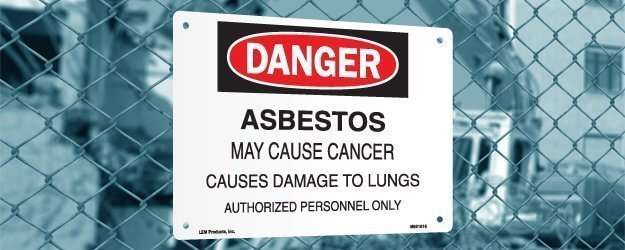
What’s Asbestos and How to Work with it Safely
Bernie Banton, a social justice campaigner, had an iconic role in spreading the word about the dangers of asbestos in Australia (and far beyond) and inspired thousands of workers to stand up for their rights against questionable practices at work.
After being diagnosed with asbestos-related diseases, Bernie fought the fight and eventually won the victory: the victims of exposure to asbestos should not be denied the compensation.
What’s Asbestos?

Image source: iCharts
And there was a good reason behind that.
Asbestos has two valuable characteristics, among others. It is fire resistant (in the mid-1850s, the Parisian Fire Brigade wore jackets and helmets made from asbestos!) and it effectively absorbs sound (which makes the material great for insulation).
After the Industrial Revolution, the use of asbestos became widespread and achieved its peak in the 1950s and 1970s. That’s when health issues started to ring an alarm. Soon, the need for strict safety regulations arose.
Australia banned the production of asbestos in 1983. Twenty years later, in 2003, the importation and use of all forms of asbestos were banned.
To understand why this decision was made, let’s peek behind the curtain of asbestos-related dangers.
What Can Asbestos Do To The Human Body?
Today, the greatest risk may come up during renovation or demolition works. When the fibres of asbestos, invisible to the naked eye, become airborne (i.e. are released into the air), they may be fatally dangerous. Much finer than the human hair, these fibres attack our bodies after we breathe them in.
As perfectly explained in this video, the needle-like particles damage lung tissues, causing inflammation. If the process persists for a long time, it leads to lung cancer and mesothelioma. Interestingly, diseases caused by asbestos may take decades to appear.
We can work around asbestos when it’s intact, but we have to make sure our work does not disturb asbestos. By “disturb” we mean, you should not drill, saw, sand, or drive a nail into an asbestos-containing material.
Everyone should know their duties when dealing with loose, exposed, and friable asbestos. The reason is — there is no minimum amount of safe exposure to this substance. Any amount can be dangerous.
Many parts of older homes, built before the 1980s, may contain asbestos, including but not limited to: floor and roofing tiles, walls and ceilings, pipe insulation, window panels, water tanks, ventilators, kitchen splashbacks, downpipes, garages and sheds, fences, gutters…

Image source: Now Environmental Services, Inc.
Industrial and commercial properties are no less likely to contain asbestos. It was widely used in ceilings, walls, beams and columns, pipes, boilers, textiles (e.g. fire blankets), gaskets, etc.
No wonder, construction practitioners are required to have a solid understanding of the industry laws, regulations, and requirements. Or else, they run the risk of being exposed to the asbestos-related hazards.
If demolition or renovation work is going to be carried out, asbestos must be removed before any work starts at the workplace.
Preparing The Asbestos Removal Plan
An asbestos removal plan should clearly outline a step-by-step process of clearing an area of asbestos, mainly:
- The location and the area to be cleared of asbestos.
- The location of the waste storage(it should be a secure place approved by local authorities to make sure the waste is isolated from the environment and does not release any fibres into the air).
- Method of removal.Two main methods are used in the removal process: wet and dry.
The wet method of removal is most preferable as it involves using water that significantly suppresses the asbestos fibres preventing their release into the air. Having said that, the wet method does not eliminate the release of fibres, so respiratory protective equipment should still be used.
The dry method lacks this advantage so should be used when the wet method is not practically possible or safe (for example, when there is live electricity in the vicinity).
Asbestos removal plan should also outline:
- The amount and type of asbestos.
- The equipment and worker facilities to be used.
- Personal protective equipment to be used.
- Air monitoring program.
Who Can Remove Asbestos?
Not everyone. Except in limited circumstances specified in the WHS Regulations, only licensed professionals are allowed to remove asbestos. Two types of licences are specified: Class A and Class B (which differ depending on the type and quantity of asbestos to be removed).
Exceptions To The Regular Prohibition.
The ban of working with asbestos does not apply if it involves: asbestos sampling and identification, removal or disposal of asbestos, laundering asbestos-contaminated clothing – all of them done in accordance with the WHS Regulations.
Also, prohibitions won’t apply when we deal with genuine research and analysis, or demonstrations for training and educational purposes.
Who Has Health And Safety Responsibilities When Removing Asbestos?
Everyone. The companies undertaking a demolition or refurbishment work must make sure everyone is safe from exposure to asbestos. Workers, in their turn, must be aware of their rights and responsibilities when dealing with asbestos or when they face an unplanned exposure.
Why?
In order to avoid scenarios like this:
On July 12, 2019, two workers were doing maintenance work at Jeeralang power station, Latrobe Valley, Melbourne, when they were “showered with” a substance that later on was identified as asbestos.
To make matters even worse, the workers did not follow the required procedures of decontamination and got in contact with other co-workers. Scared and shocked, everyone is left with one option: wait and see if the exposure will cause any health issues.
Unfortunately, this power station’s example is not an exception.
A quick search showed up two other recent cases.
At Port Adelaide’s Shed 26, the workers are reported to have swept the disturbed asbestos, posing potential harm to schoolchildren and employees. Another report comes from the Essendon North Primary School, where asbestos was discovered during renovation works and “a layer of dust has been allowed to gather on [students’] belongings”.
Removal of asbestos from homes, schools, and workplaces is a process that might require collaboration to prevent any unsafe contact with the substance.
If needed, consult with the site management or the project manager, workers, health and safety representatives, building occupants and others to make sure all necessary measures are taken to minimize or eliminate exposure to asbestos.
Asbestos Removal Work In Progress
First, you need to limit access, display signs, and install fences and barricades. Signs should be used to inform people that it is an asbestos removal area. It may also be appropriate to use locking access doors as long as it does not create an evacuation hazard.

Image source: LEM Products, Inc.
The licensed asbestos removalist has the right to give directions to people working in the removal area. Complying with those directions is a must to ensure everyone’s safety.
Waste Containment And Disposal.
Before the waste is removed, the licensed specialist must ensure it’s labelled following the GHS (Globally Harmonized System) guidelines and removed to an area specifically meant for asbestos waste disposal.
Clearance Inspection.
Even after the waste is removed, you are not done. It’s time for clearance inspection.
Before the site can be re-occupied, a certificate should be issued by an independent assessor. By independent, we mean that the assessor must not be involved in the removal process for that specific job.
Let’s Wrap Up!
People in construction have so many responsibilities to take care of. Each party involved in construction work has its share of responsibility when it comes to health and safety of those constructing, demolishing or renovating a building.
From managers to engineers, from plumbers to builders — everyone needs a comprehensive training to guard their own and others’ safety. The good news is: with the right training provider, the learning process is not at all complex and intimidating.
Back to Basics, a nationally recognized training provider, enables you to upgrade your skills through a program that makes learning easy and effective.
Here is how:
- You learn at your own pace.
- You study when you want from any device, anywhere in the world.
- You gain access to training materials written by builders for builders.
- You receive one-on-one training from industry experts.
- Your tuition fee is all-inclusive (learning materials, support, administration).
Call us on 1300 855 713 or email enquiries@backtobasics.edu.au to find out more.